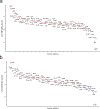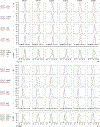Surface phenotypes of naive and memory B cells in mouse and human tissues
- PMID: 34937918
- PMCID: PMC8712407
- DOI: 10.1038/s41590-021-01078-x
Surface phenotypes of naive and memory B cells in mouse and human tissues
Abstract
Memory B cells (MBCs) protect the body from recurring infections. MBCs differ from their naive counterparts (NBCs) in many ways, but functional and surface marker differences are poorly characterized. In addition, although mice are the prevalent model for human immunology, information is limited concerning the nature of homology in B cell compartments. To address this, we undertook an unbiased, large-scale screening of both human and mouse MBCs for their differential expression of surface markers. By correlating the expression of such markers with extensive panels of known markers in high-dimensional flow cytometry, we comprehensively identified numerous surface proteins that are differentially expressed between MBCs and NBCs. The combination of these markers allows for the identification of MBCs in humans and mice and provides insight into their functional differences. These results will greatly enhance understanding of humoral immunity and can be used to improve immune monitoring.
© 2021. Springer Nature America, Inc.
Conflict of interest statement
Competing Interests Statement
Authors declare that they have no competing financial interest.
Figures














References
Publication types
MeSH terms
Substances
Grants and funding
LinkOut - more resources
Full Text Sources
Molecular Biology Databases

